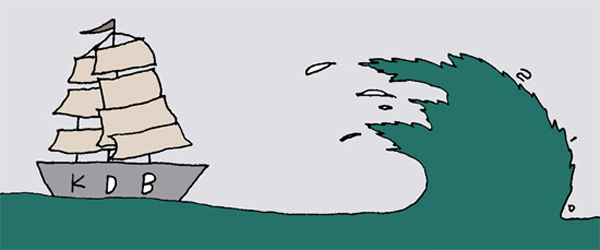The curse of the negative spread

ING reduced the number of offered products and let anyone sign up easily. It also offered higher rates. The result was a great success, with more than 15 million customers in nine countries, including the United States, the United Kingdom and Canada.
Benchmarking the success of ING, HSBC began a direct banking operation in Korea. In February 2007, then-CEO Simon Cooper introduced “HSBC Direct” and held a press conference at the Hilton Hotel, Seoul. They pledged to approach the customers directly and offer 1 to 2 percent higher interest rates than other banks. It seemed like good business, but the result was catastrophic. HSBC stopped selling the direct banking products less than a year later because offering such high interests created a larger negative spread than expected.
When KDB Financial Group CEO Kang Man-soo introduced “KDB Direct” two years ago, the market had mixed forecasts. Kang seemed to focus on success and snapped at the concerns of a negative spread. He claimed that KDB’s good rating allowed the bank to bring funds at cheap rates. When other banks offered a mid-3 percent interest rate on average, KDB Direct offered 4 percent. He personally explained the business structure to the reporters. It may have been an inevitable choice for KDB, which has only 60 branches. It was a way to prepare a foundation as a commercial bank and enable privatization. One year and four months later, KDB Direct amassed 9 trillion won ($8.07 billion) in deposits.
The public servants’ asset disclosure last weekend confirmed the popularity of direct banking. KDB Direct was the choice of banking services among the heads of public financial corporations who are knowledgeable in the field. Kang made a new deposit of 350 million won last year, and the CEO of the Korea Deposit Insurance Corporation, the director of the Korea Credit Guarantee Fund, and the CEO of Kamco deposited 70 to 190 million won. But excessive popularity often attracts jealousy, and in the end, commercial banks who lost potential customers complained. They criticized that the government was virtually involved in the banking industry, and the direct banking would ultimately collapse because of the negative spread.
Perhaps because of the industry’s criticism, the Board of Audit and Inspection named KDB Direct as a “negative spread product” when it released the public financial corporation inspection report last month. The timing is also interesting, as it came right after the president’s remark on the reshuffle of public corporation heads. Last weekend, Kang tendered his resignation. He would never have dreamed that the hottest product for KDB would end up being the reason for his departure.
*The author is an editorial writer of the JoongAng Ilbo.
by Yi Jung-jae
금융사에 남을 히트상품 중 하나가 다이렉트 뱅킹이다. 네덜란드 금융그룹 ING가 1997년 미국 시장 진출 때 처음 들고 나왔다. 왜 다이렉트인가. "세일즈맨이 20초 내에 상품을 설명할 수 없다면 팔지말라" "고객을 기다리지 말고 직접 찾아가라" "가입 절차는 신속·간편해야 한다" 는 의미다. ING는 우선 상품 수를 확 줄였다. 온라인으로 누구나 쉽게 가입할 수 있게 했다. 대신 이자를 더 줬다. 미국에 점포망이 없는 ING로선 어쩔 수 없는 선택이기도 했다. 결과는 대성공, 미국은 물론 영국·캐나다 등 9개국에서 1500만 명의 고객을 끌어들였다. 이걸 벤치마킹해 한국에 들여온 게 HSBC은행이다. 2007년 2월 사이먼 쿠퍼 당시 행장은 'HSBC 다이렉트'를 선보였다. 이례적으로 서울힐튼호텔에서 기자간담회도 열었다. 고객을 직접 찾아가고 하루만 맡겨도 이자 지급, 시중 은행 평균보다 1~2%포인트 높은 금리. 도무지 실패할 것 같지 않았지만 결과는 대실패, HSBC는 1년도 안돼 판매를 중단했다. 이자를 많이 얹어주다 보니 역마진이 예상보다 컸다는 게 이유다. 큰 실패냐 대성공이냐. 강만수 산은금융지주 회장이 2년 전 'KDB 다이렉트' 를 내놓았을 때, 시장의 평가도 반반이었다. 그는 '대박' 쪽만 생각한듯했다. 세간의 역마진 우려는 일축했다. 정부만큼 신용이 좋으니 싼 자금 조달이 가능하다는 이유였다. 시중은행이 평균 연 3% 중반의 이자를 줄 때 4%를 줬다. 기자들을 불러 직접 설명도 했다. 점포가 60개밖에 없는 산은으로선 어쩔 수 없는 선택이란 얘기도 했다. 그래야 소매금융 기반을 닦고, 산은 민영화가 가능하다고 주장했다. 결과는? 1년 4개월 만에 9조 원의 자금이 몰렸다. 다이렉트의 인기는 지난 주말 공직자 재산 공개에서도 확인됐다. 금융을 좀 안다는 금융공기업 수장들이 꼽은 최고 인기상품이 'KDB 다이렉트'였다. 강만수 회장(3억5032억 원)을 비롯, 예금보험공사 사장, 신용보증기금 이사장, 캠코 사장 등이 7000만~1억9595만 원을 지난해 새로 예금했다. 인기는 시샘을 부르게 마련, 결국 사달이 났다. 자금을 뺐긴 시중은행들의 볼멘 소리가 터져나왔다. "정부가 플레이어로 뛰는 셈" "역마진에 걸려 좌초할 것"이란 비난이 쏟아졌다. 이런 비난 탓이었을까. 감사원은 지난달 중순 금융 공기업 감사결과를 발표하면서 KDB 다이렉트를 꼭 집어 '역마진 상품'으로 규정했다. 시기도 묘했다. 대통령의 공공기관장 물갈이 발언 직후였다. 결국 지난 주말 강 회장은 사의를 밝혔다. 산업은행 최고의 히트 상품 다이렉트, 그게 자신의 발목을 잡는 구실로 돌아올 줄 2년 전 강 회장은 꿈에나마 생각했을까. 이정재 논설위원










with the Korea JoongAng Daily
To write comments, please log in to one of the accounts.
Standards Board Policy (0/250자)